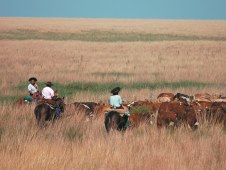
In 2006, BirdLife Partners in Uruguay, Argentina, Brazil and Paraguay formed the Southern Cone Grasslands Alliance to promote sustainable cattle grazing practices. Working with cattle ranchers to promote more responsible production, the alliance is enhancing the integrity and resilience of the grasslands and ensuring ongoing carbon sequestration and storage.
The grassland biome of southern South America makes up 700,000 km, spanning parts of Brazil, Argentina, Uruguay and Paraguay. Grasslands are important for carbon sequestration (Scurlock and Hall 1998) and this biome has a rich avian diversity, with 25 species holding a threatened or near threatened global status, including Endangered Yellow Cardinal Gubernatrix cristata (Di Giacomo and Krapovickas 2005, BirdLife 2015). Nine neotropical migrants winter in the south American grasslands (Giacomo and Krapovickas 2005), including Buff-breasted Sandpiper Calidris subruficollis (Lanctot et al. 2010, Giacomo and Krapovickas 2005,) and American Golden Plover Pluvialis dominica (Clay et al. 2010, Giacomo and Krapovickas 2005), who travel from their breeding grounds in the North American tundra.
This biome is however under threat; 25% of these grasslands have been lost in the past three decades due to land use change. Increases in cattle, wheat, soybean and exotic tree cultivation have been seen, with low productivity of pastures resulting in severe overgrazing. Despite these threats, only 0.5% of the South Brazilian grasslands are currently under legal protection (Overbeck et al. 2007). This makes sustainable management of unprotected land, and understanding how species respond to management, of importance in ensuring both humans and wildlife can persist in a changing climate. Buff-breasted Sandpiper for example has been shown to be well supported by continuous grazing, whereas the Bay-capped Wren-Spitetail Spartonoica maluroides relies on tall grasslands with lots of cover (Isacch and Cardoni 2011).
In 2006 BirdLife Partners in Uruguay, Argentina, Brazil and Paraguay formed the Southern Grassland Alliance to promote sustainable cattle grazing practises. Laguna de Rocha—a site identified as an IBA for the Buff-breasted Sandpiper and American Golden Plover—is one site that the Grassland Alliance project is being piloted. A combination of academic research, traditional knowledge and the monitoring of grassland bird populations are being used to develop the most appropriate grassland management practices for each species of conservation concern. Information generated through the research and monitoring programme is being used to inform decisions regarding stocking rates, rotation cycles and other aspects of livestock management by producers to help create appropriate habitat for Buff-breasted Sandpiper and American Golden Plover.
This case study is taken from ‘The Messengers: What birds tell us about threats from climate change and solutions for nature and people’. To download the report in full click here.
Related Case Studies in other sections
Related Species
Links
Southern cone grassland alliance activities support shorebird conservation in Uruguay
References
Compiled: 2014 Last updated: 2015 Copyright: 2015
Recommended citation:
BirdLife International (2015)
Developing sustainable agricultural systems in the Southern Cone grasslands.
Downloaded from https://datazone.birdlife.org/sowb/casestudy/developing-sustainable-agricultural-systems-in-the-southern-cone-grasslands on 22/12/2024